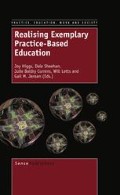Abstract
This chapter describes and discusses the use of computer-based simulation in undergraduate nursing, to train basic manual clinical skills, using the example of urethral catheterisation at a clinical skills centre. It aims to give a rich account of the pedagogic arrangements and settings for such training, and to explore students’ views on necessary conditions and their practices of learning in this context.
Access this chapter
Tax calculation will be finalised at checkout
Purchases are for personal use only
Preview
Unable to display preview. Download preview PDF.
References
Antepohl, W., Domeij, E., Forsberg, P., & Ludvigsson, J. (2003). A follow-up of medical graduates of a problem-based learning curriculum. Medical Education, 37(2), 155–162.
Barrows, H. (1985). How to design a problem-based curriculum for the preclinical years. New York: Springer.
Bradley, P. (2006). The history of simulation in medical education and possible future directions. Medical Education, 40, 254–262.
Faresjö,T., Wilhelmsson, M., Pelling S., Dahlgren, L. O., Hammar, M. (2007). Does inter-professional education jeopardise medical skills? Journal of Interprofessional Care, 21(5), 573–576.
Hatala, R. (2011). Practice makes perfect … sometimes. Medical Education, 45, 114–116.
Issenberg, S. B., McGaghie, W. C., Petrisa, E. R., Gordon D. L., & Scalese, R. J. (2005). Features and uses of high-fidelity medical simulations that lead to effective learning: A BEME systematic review. Medical Teacher, 27, 10–28.
Johannesson, E. (2012). Learning manual and procedural clinical skills through simulation in health care education. Licentiate thesis. Linköping University. Linköping: LiU-Tryck. Retrieved from http://liu.diva-portal.org/smash/record.isf?searchId=1&pid=diva2:507532 .
Johannesson, E., Silén, C., Kvist, J., & Hult, H. (2012). Students’ experiences of learning manual clinical skills through simulation. Advances in Health Sciences Education. doi: 10.1007/s10459-012-9358-z
Jöud, A., Sandholm, A., Alseby, L., Petersson, G., & Nilsson, G. (2010). Feasibility of a computerized male urethral catheterization simulator. Nurse Education in Practice, 10(2), 70–75.
Khan, K., Pattison, T., & Sherwood, M. (2011). Simulation in medical education. Medical Teacher, 33, 1–3.
Kjellgren, K., Ahlinder, J., Dahlgren, L. O., & Haglund, L. (1993). Problembaserad inlärning – erfarenheter från Hälsouniversitetet (Problem-based learning – Experiences from the Faculty of Health Sciences). Lund: Studentlitteratur.
Marton, F., & Booth, S. (1997). Learning and awareness. Mahwah, NJ: Lawrence Erlbaum.
McGaghie, W. C., & Issenberg, S. B. (2010). A critical review of simulation-based research: 2003–2009. Medical Education, 44, 50–63.
Melerit UrecathVision. Product information for computer simulator UrecathVision. Retrieved from http://www.meleritmedical.com .
Norman, G. R., & Schmidt, H. G. (1992). The psychological bases of problem based learning: A review of the evidence. Academic Medicine, 67, 557–565.
Savery, J. R., & Duffy, T. M. (1995). Problem-based learning. An instructional model and its constructivist framework. Educational Technology, 35, 31–38.
Swedish National Agency for Higher Education. (2007). Utvärdering av grundutbildningar i medicin och vård vid svenska universitet och högskolor. Högskoleverket [Swedish National Agency for Higher Education. Report No. 23].
Tun, J. K., & Kneebone, R. (2011). Bridging worlds: Applying the science of motor learning to clinical education. Medical Education, 45, 111–114.
Wulf, G., Shea, C., & Lewthwaite, R. (2010). Motor skill learning and performance: A review of influential factors. Medical Education, 44, 75–84.
Author information
Authors and Affiliations
Editor information
Editors and Affiliations
Rights and permissions
Copyright information
© 2013 Sense Publishers
About this chapter
Cite this chapter
Johannesson, E., Hult, H., Dahlgren, M.A. (2013). Simulating the Real - Manual Clinical Skills Training. In: Higgs, J., Sheehan, D., Currens, J.B., Letts, W., Jensen, G.M. (eds) Realising Exemplary Practice-Based Education. Practice, Education, Work and Society, vol 7. SensePublishers, Rotterdam. https://doi.org/10.1007/978-94-6209-188-7_20
Download citation
DOI: https://doi.org/10.1007/978-94-6209-188-7_20
Publisher Name: SensePublishers, Rotterdam
Online ISBN: 978-94-6209-188-7
eBook Packages: Humanities, Social Sciences and LawEducation (R0)


